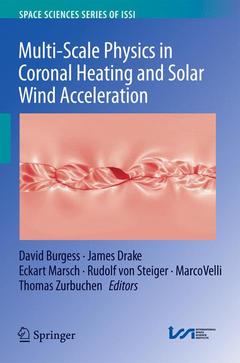Description
Multi-Scale Physics in Coronal Heating and Solar Wind Acceleration, 2013
From the Sun into the Inner Heliosphere
Space Sciences Series of ISSI Series, Vol. 38
Coordinators: Burgess David, Drake James, Marsch Eckart, Steiger Rudolf, Velli Marco, Zurbuchen Thomas
Language: English
Subjects for Multi-Scale Physics in Coronal Heating and Solar Wind...:
Publication date: 06-2015
Support: Print on demand
Publication date: 01-2013
409 p. · 15.5x23.5 cm · Hardback
Description
/li>Contents
/li>Biography
/li>Comment
/li>
This volume explores the cross-linkages between the kinetic processes and macroscopic phenomena in the solar atmosphere, which are at the heart of our current understanding of the heating of the closed and open corona and the acceleration of the solar wind. The focus lies on novel data, on theoretical models that have observable consequences through remote sensing, and on near-solar and inner-heliosphere observations, such as anticipated by the upcoming Solar Orbiter and Solar Probe missions, which are currently developed by the international community.
This volume is aimed at students and researchers active in solar physics and space science.
Previously published in Space Science Reviews journal, Vol. 172, Nos. 1-4, 2012.
James Drake is a professor of physics and the University of Maryland College Park. He earned his bachelors degree from UCLA and remained at UCLA to complete his doctorate in theoretical physics in 1975. After completing his doctorate, Professor Drake remained at UCLA for a brief time as a post-doctoral scholar and then moved to the University of Maryland first as a post-doctoral scholar and then as a member of the teaching faculty in the Department of Physics and the Institute for Physical Science and Technology. Professor Drake has worked on a very broad range of topics in the general area of theoretical plasma physics using both analytical and numerical techniques. His work has applications spanning a variety of physical systems, including the solar corona, the earth's magnetosphere and ionosphere, magnetically confined plasma, and the interaction of intense lasers with plasma. His present focus is on magnetic reconnection with space physics applications and turbulence and transport with applications to the magnetic fusion program. In recognition for his contributions to the field of plasma physics, he was granted fellowship status in the American Physical Society and was awarded a Humboldt Senior Scientist Research Award.
Dr. Rudolf von Steiger is the director of the International Space Science Institute in Bern, Switzerland. His research is primarily about the solar wind, mainly using data from SWICS on Ulysses. He also lectures at the University of Bern, where he earned his PhD in experimental physics in 1988.
Dr. Marco Velli has taught mechanics, electromagnetism, astrophysicsand plasma physic
These books may interest you

New Millennium Solar Physics 189.89 €



